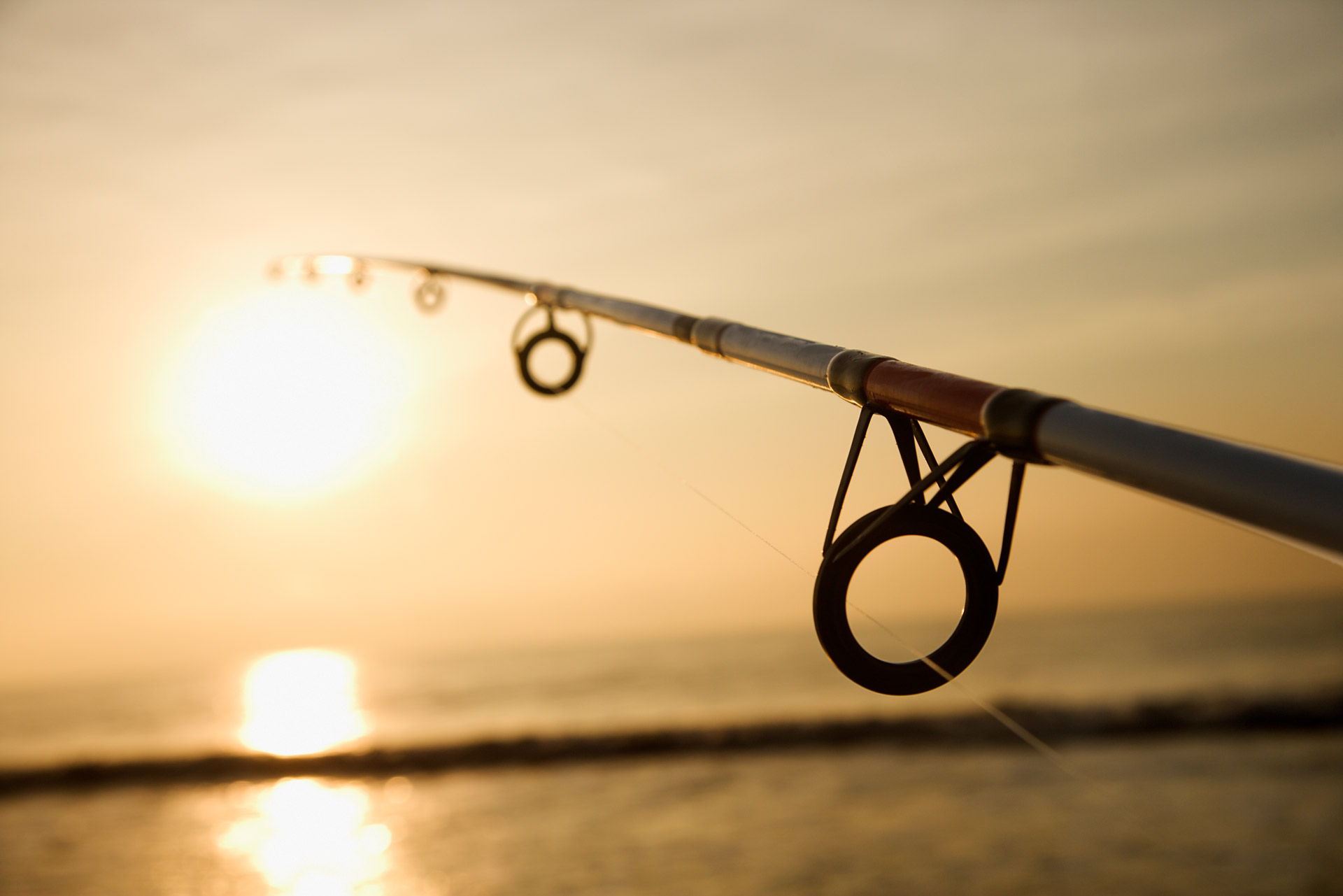Smallmouth vs Largemouth Bass : The Differences
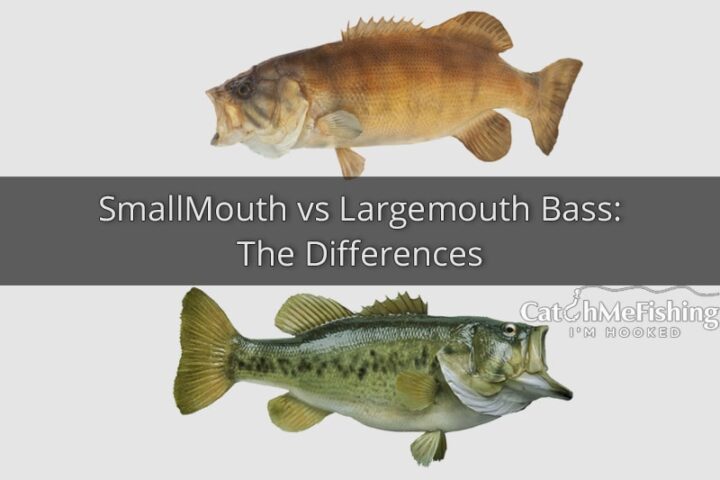
Bass is a special fish for every fisherman, with tens of millions of people enjoying bass fishing each year. But what makes them so unique and interesting?
If you have seen trophy-sized bass, you know the answer to this question and if you are wondering whats the differences between smallmouth vs largemouth bass then we have you covered and explain it all below.
Bass has a plethora of species that vary in size, color, weight, length, and features. Some of the most popular kinds of bass are largemouth and smallmouth bass, spotted and striped bass, white, black, yellow, and Guadalupe bass.
Of course, each one requires a special technique and strategy. So knowing the difference between the species’ characteristics would be essential for planning strategic fishing.
The more you know about bass, the closer you are to catching them.
Largemouth and smallmouth bass are the most demanded and famous among fishers. They are alike in many ways but at the same time, they are unique.
Now, let’s dive into more details about the differences and similarities between the largemouth and smallmouth bass.
Appearance of Smallmouth VS Largemouth Bass
Smallmouth Bass Appearance
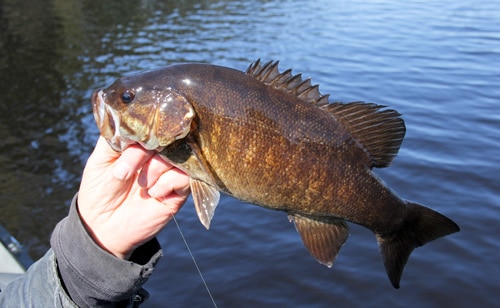
-
- Color: Smallmouth bass is brownish-green or sometimes even black with a yellowish-white underside. It has brown vertical lines on its sides and horizontal dark-brown lines on its head.
- Anatomy: Smallmouth bass has an elongated body form with the dorsal fin divided in two and nine spines on the front.
- Teeth: it has small, inward-facing, needle-like teeth, unlike many fish who have sharp teeth.
- Eyes: smallmouth bass can have either red or brown eyes.
- Jaw: smallmouth jaw expends to the middle parts of its eye.
- Size: the average length of caught smallmouth bass is 30.5-40.6 cm/12-16 in. The maximum length known to us is 69 cm/27.2 in.
- Weight: The average weight of a mature smallmouth is 3 kg/6.6 lbs. the maximum weight of smallmouth bass that is reported is 5.4 kg/11 lbs 15 oz.
Largemouth Bass Appearance
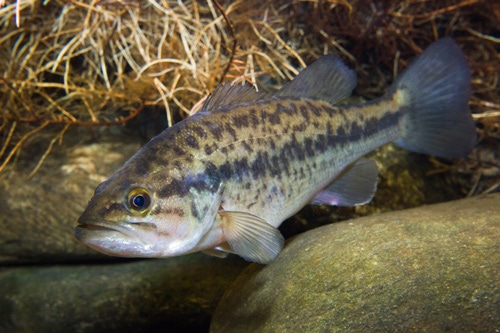
- Color: mostly largemouth bass are dark brown, olive, dark green. Just like a chameleon, largemouth can change colors if you take a closer look at it. Its sides are covered with dark spots that form a horizontal pattern.
- Anatomy: as we can tell from the name, it has a lot bigger mouth compared to smallmouth bass. Also, its dorsal fins are separated in two.
- Teeth: it has small, inward-facing, needle-like teeth just like smallmouth.
- Eyes: largemouth eye color vary. We can encounter red, orange, white, silver, green-eyed bass depending on the location.
- Jaw: largemouth bass jaws expand past its eye.
- Size: the average length of largemouth bass is 40 cm/15.7 in.
- Weight: largemouth grows much bigger than smallmouth. The average weight of it is up to 6.8 kg/15 lb.
How to tell the difference between Smallmouth VS Largemouth Bass
Considering the massive physical difference between the largemouth and smallmouth bass, you’ll find it very easy to distinguish them.
First, look at the size of their body, mouth, and general form. You’ll notice the difference straight away. But, the smallmouth record is 69 cm/27.2 in, therefore it’s possible to catch a huge smallmouth.
If in doubt, look at the color, body patterns, and eye color. Check the dorsal fin and jaw structure.
Where to find Smallmouth VS Largemouth Bass
If you’re going after largemouth or smallmouth bass you definitely need to know their habitat and usual locations. You can rarely find them together since they have different temperature preferences.
Let’s take a look at the areas that are inhabited by them.
Smallmouth Bass Habitat
Generally smallmouth bass prefers places with a cooler temperature.
Unlike largemouth bass, clear water is a priority to them. Therefore, they inhabit clear lakes, water streams, rivers.
Smallmouth is a good indicator of clean water, as you will never find them in polluted water.
You can find smallmouth bass in rocky areas, sandy bottoms, and stumps.
Smallmouth that live in rivers are commonly found in fast-flowing areas.
Smallmouth bass usually hunts around the cover but doesn’t enter it.
Largemouth Bass Habitat
Largemouth usually inhabits crystal clear, vegetated lakes, ponds, swamps, and other water bodies such as creeks and rivers.
It looks for spawning areas with a firm bottom of sand, gravel, or mud.
Largemouth prefers warmer temperature compared to smallmouth bass.
Strategic areas to search for lunker largemouth bass are rocks, stumps, grasses, brush piles, weed beds, and other places of this sort. Largemouth bass hunt in covers.
Eating Habits of Smallmouth VS Largemouth Bass
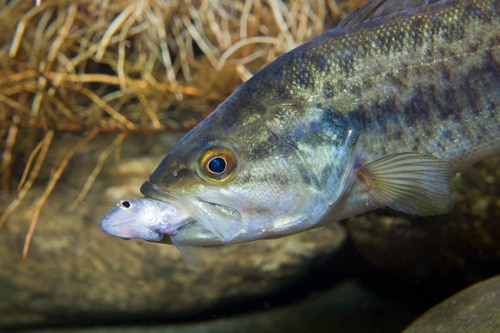
Smallmouth and largemouth diets have a lot in common but there are also many differences.
They both eat anything that comes across and looks attractive to them.
For instance, adult bass consume worms, crawfish, salamander, shrimp, scuds, and many other creatures. Juvenile bass eat small fish, insects, and worms.
Now, let’s talk about the differences between their eating habits.
Unlike largemouth bass, smallmouth doesn’t rely on the cover for food. It can travel large distances without the cover and live in the open water.
Largemouth heavily depend on the cover. They find strategic places to hide from the prey and attack them out of the blue but this tactic is deadly for them as it makes their location very predictable for fishers. Therefore, it’s much easier for us to find them hiding in the covers, we just need to search for a good cover.
How to Catch Smallmouth VS Largemouth Bass
Fishing for largemouth and smallmouth bass doesn’t differ too much but there are some strategies that you should consider if you want to target a specific type of bass.
Let’s dive deeper into more details about catching Smallmouth and largemouth bass.
Smallmouth bass fishing tactics
Fishing jigs are one of the most practical fishing lures for smallmouth bass.
Spoons are an old and well-experienced method of catching the smallmouth so, you should definitely give it a try.
Smallmouth will be provoked by anything that is moving and looks interesting to them. They will bite the bait in no time after seeing it, so catching smallmouth is a little easier than the largemouth.
Largemouth bass fishing tactics
Since largemouth depend on covers, it would be strategic to use weedless skirted jigs, spinnerbaits, fishing soft plastic, and many other baits.
If you’re going after largemouth in crips and brush piles crankbaits would come in handy. I always have great success with rigs like the Carolina rig.
Fish ignore lures if they are in bed unless you throw it in their face. In this case, large plastic and jigs work just fine.
Ready the fish?
We can’t say which one is better, largemouth or smallmouth, but largemouth bass is the most popular due to its abundance in the USA.
Now that you know the main differences and similarities between smallmouth and largemouth bass, you are one step closer to catching either a normal-sized bass or a lunker largemouth.
Make sure to go through the fishing tactics in order to enjoy your trip to the fullest.
Have a strategic and enjoyable fishing experience, tight lines! 🙂



